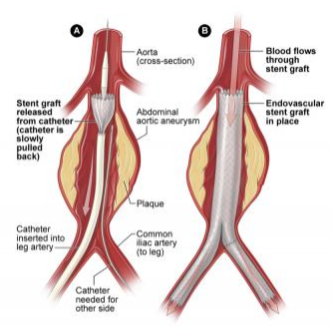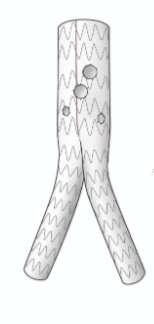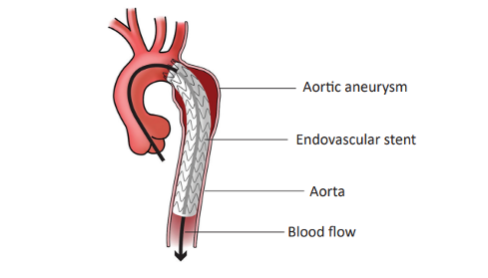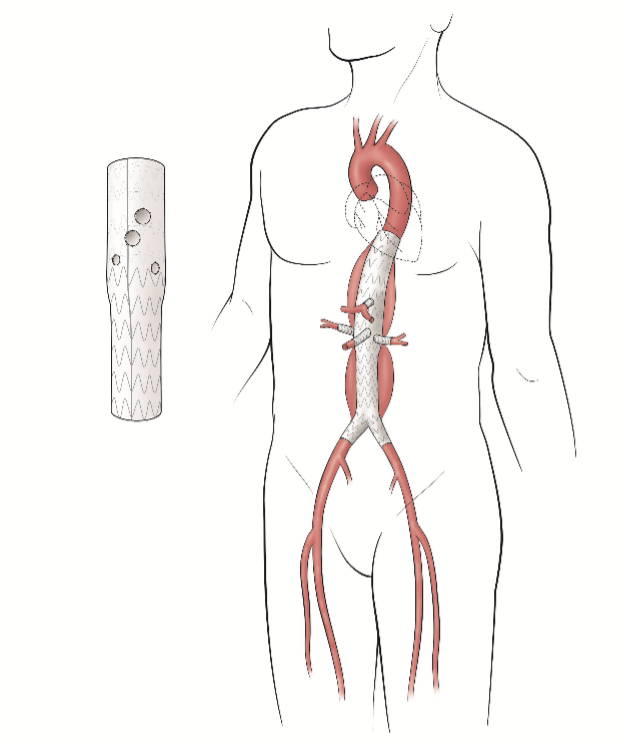Endovascular Options for Aortic Aneurysm
TALK TO AN AORTIC NURSE
Endovascular Options for Abdominal Aortic Aneurysm
The Northwestern Medicine Center for Aortic Care at Bluhm Cardiovascular Institute performs minimally invasive (endovascular) repair surgery to treat certain abdominal aortic aneurysms (AAAs). An AAA is a bulging or weak spot in the aorta below the level of the diaphragm.
Endovascular repair surgeries include:
- Endovascular aortic repair (EVAR)
- Fenestrated endovascular aortic repair (FEVAR), also called branched endovascular aortic repair (BEVAR)
Endovascular repair surgery is needed when an AAA reaches a significant size. The type of repair needed depends on the location and size of the AAA. Your care team will talk with you about treatment options. They will explain procedures and answer your questions.
Endovascular repair surgeries have several benefits because they are minimally invasive, including:
- Less pain
- Faster return to normal daily activities
- Less blood loss
- Improved clinical outcomes
- Smaller incisions with less scarring
- Shorter recovery time
Endovascular Aortic Repair (EVAR)
A surgeon will insert a small catheter (hollow, flexible tube) into your femoral (leg) artery through a tiny incision in your groin area. The catheter has a stent graft (usually a metal mesh tube covered with fabric).
Then, the surgeon moves the catheter into the diseased part of the abdominal aorta. This enables them to place the graft. The graft directs blood through the graft and away from the aneurysm.

Fenestrated Endovascular Aortic Repair (FEVAR) or Branched Endovascular Aortic Repair (BEVAR)
"Fenestrated" or "branched" endovascular grafts are unique endovascular grafts that treat complex AAA.
The surgeon removes the diseased aorta and replaces it with a graft. The aorta has many arteries that provide blood to the many parts of the body. The surgeon detaches these arteries from the aorta. Then, they replace part of the arteries with fenestrated grafts to restore blood flow. Fenestrated grafts and branched grafts have small openings. They are customized to fit the patient’s aortic needs. This restores blood flow.

Endovascular options for thoracic aortic aneurysm include:
- Thoracic endovascular aortic repair (TEVAR)
- Fenestrated endovascular aortic repair (FEVAR)
Endovascular repair surgery is needed when a thoracic aortic aneurysm reaches a significant size. The type of repair offered depends on the location and extent of the aneurysm. Your care team will talk with you about treatment options. They will explain procedures and answer your questions.
Endovascular repair surgeries have several benefits because they are minimally invasive:
- Less pain
- Faster return to normal daily activities
- Less blood loss
- Improved clinical outcomes
- Smaller incisions with less scarring
- Shorter recovery time
How Endovascular Repair Surgery Works
A surgeon inserts a small catheter (hollow, flexible tube) into your femoral (leg) artery through a tiny incision in your groin area. The catheter has a stent graft (usually a metal mesh tube covered with fabric).
Then, the surgeon moves the catheter into the diseased part of the thoracic aorta. This enables them to place the graft. The graft directs blood through the graft and away from the aneurysm or dissection.
Thoracic Endovascular Aortic Repair (TEVAR)
During TEVAR, the surgeon uses special tools and X-rays to guide an expandable stent graft through your femoral artery into the aorta. The surgeon places the expandable graft inside the damaged aorta and opens it. This makes the graft expand and fit snugly in place.

Fenestrated Endovascular Aortic Repair (FEVAR)
"Fenestrated" endovascular grafts are unique grafts customized to fit the patient’s aortic needs. Fenestrated grafts have small openings that allow blood flow to be restored to the arteries that branch off of the aorta and supply blood to critical organs.
The surgeon removes the diseased aorta and replaces it with a graft. The aorta has many arteries that provide blood to different parts of the body. The surgeon detaches these arteries from the aorta. Then, they replace part of the arteries with fenestrated grafts to restore blood flow.

Meet the Aortic Aneurysm Team


